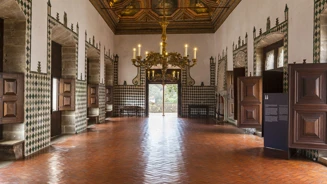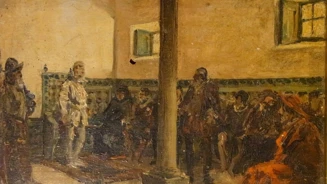Did Camões read The Lusiads to King Sebastião at the Palace of Sintra?
07 Jun 2024
On the 500th anniversary of Luís Vaz de Camões - which will be celebrated in 2024 - we will try to solve one of the historical mysteries of Portuguese literature, which involves the great poet and Sintra: is it true that Camões read The Lusiads to King Sebastião on the Audience Patio of the National Palace of Sintra? Some people from Sintra will answer without hesitation that it is, and several tourist guides do not shy away from passing this information on to visitors as if it were a given, but many wonder about the veracity of this story. Is it fact or fiction?
Many will be disappointed by the answer: the truth is that, based on the investigations that have been carried out over the years by the team of curators at the National Palace of Sintra, there are no sources to prove the story of this encounter. It is essentially a story that was fabricated in more recent times.
So how did a story like this gain so much traction? First point: everything that involves the figure of King Sebastião gains a mystical aura in some way, shape or form. As one of the monarchs who is most well-known to the general public - the legend surrounding his death made him one of the most popular -, it is natural that many of the stories involving him gain some dimension in terms of oral tradition. Second point: one of the main authors of this story was (and still is) someone with great influence in Portugal, considered one of the main figures of Portuguese Romanticism: Almeida Garrett.

In the well-known poem Camões (1825), more specifically in cantos VII and VIII, the writer tells how the poet himself narrated The Lusiads to King Sebastião. Here are some verses:
‘And the king, as if restless, to the old tutor:‑
— “Dom Aleixo, among so many suitors
I do not see your protégé.”
— “Here he is, sir, the noble knight
Whom you wish to hear.”
— «Yes, I want to hear it,
I want and I desire: I am not ignorant of the price
Of good literature, nor of a rare wit
I do not value esteem: for the sake of the country
Some of us work with the sword; others must
Honour it with the pen.”’
At the time, Almeida Garrett had set the reading at Penha Verde (which is now private property) and not at the Palace of Sintra:
— ‘We will go, to listen to you,
At Penha Verde, we will sit in the coolness.
Time goes by calmly; and besides, the gifts
Of the muses are doubled in pleasure among the greenery.’
This work by Garrett became very popular and the moment when Camões read the first Portuguese epic to the monarch quickly became ingrained in the collective imagination. A few decades later, the Count of Sabugosa attempted to demystify this issue in his work O Paço de Cintra (The Palace of Sintra):
‘It could also have been around this time [around 1577] that Camões stayed in Sintra, if the fantasy conceived by Garrett in his poem had any basis. It is enough to tempt the imagination. In front of the young King, a dreamer, mystic and warrior, the captain of Diu, surrounded by wild and reckless courtiers; Camões, the poet and knight, reciting The Lusiads in that setting that King João de Castro had created! What a scene! Unfortunately, there is nothing to indicate that the scene conceived by Garrett and other writers, seduced by the possibility of such an evocative plot, has any basis in reality.’
The German poet Wilhelm Storck shows in his book Vida e Obras de Luís de Camões (The Life and Works of Luís de Camões) (1897), translated into Portuguese by Carolina Michaëlis de Vasconcellos, that there are even temporal inaccuracies that end up destroying this story:
‘The romantic Almeida Garrett was, as far as I know, the first to speak of a meeting between Camões and King Sebastião, presenting in his lyrical epic drama our poet in the act of placing his poem into the hands of the monarch. It is in Sintra. The adolescent Sovereign, sitting in the cool shade of Penha Verde, listens enthusiastically to the retelling of the heroic deeds of his ancestors and his people, absorbed in the words being recited from the Poet's trembling lips. The King's illustrious tutor, the experienced statesman and patriotic nobleman, Aleixo de Menezes, had served as an intermediary. It is a pity that the poetic fiction goes up in smoke as soon as we look at it more closely, reminding us that King Aleixo had already died in 1569, before Camões returned from India, wounded to the core of his heavy heart upon seeing how all of his advice had been disregarded, and the young monarch had been led by pernicious influences that systematically led him astray.’
There is another aspect to take into account: the way the court functioned at the time. ‘By the time of King João III, the life of the Court had changed, and his grandson was almost unreachable, only inclined toward hunting and physical exercise, as preparation for battles and wars. Of the many chroniclers that King Sebastião had, not a single one mentions such a fact. The ode to King Manuel of Portugal and another poem, addressed by Camões himself directly to his King and Lord, are equally silent,’ wrote the Count of Sabugosa in ‘O Paço de Sintra’. ‘It is clear, therefore, that Camões’ stay in Sintra, and his attendance at the Palace at this time, although not impossible, since some of the figures coexisted, is nevertheless undocumented,’ he adds.

And why did the National Palace of Sintra begin to be associated with this moment, if the poem by Almeida Garrett - who, by all accounts, is the ‘creator’ of this story - sets the action at Penha Verde?
The answer in fact lies in later artistic constructions. Although there are engravings that illustrate the moment in the middle of the Sintra Hills (like this one), most artistic representations depict this reading of The Lusiads on the Audience Patio of the National Palace of Sintra (a space that is accessible to the public when weather conditions permit). One such example is a study by Enrique Casanova, which represents the Council of King Sebastião at the Palace of Sintra and, according to some interpretations, one of the figures represented is Camões. It belonged to Queen Amelia and was exhibited in her Office at the National Palace of Pena. Another, more recent example, is the film Camões (1946). The scene was not filmed on the Audience Patio, but this space served as a model for the set design.
Putting all of this information together, ‘it is clear that, once the myth was released by Almeida Garrett, oral tradition and other images were created that make it difficult to erase these outlines from the imagination of collective memory today,’ explains the curator of the National Palace of Sintra, Cláudio Marques. ‘It is an episode that lacks historical documentation to prove it,’ he adds.
CONCLUSION: Fiction
